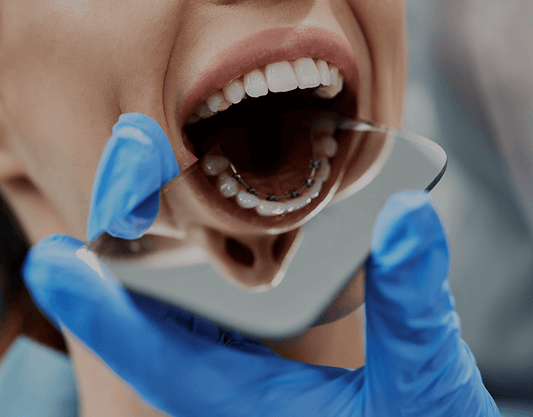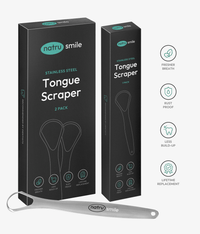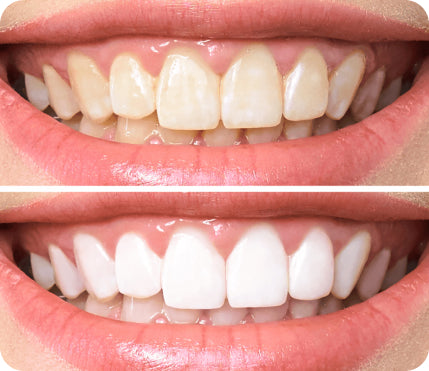
All products are certified by dental expert Dr. Greg Grillo
Are you thinking about undergoing orthodontic treatment to achieve that picture-perfect, straight smile but dread the thought of sporting traditional metal braces for all to see? Lingual braces may just be the ideal solution you've been searching for. In this extensive and informative guide, we will delve deep into the captivating world of lingual braces, leaving no stone unturned.
From understanding their costs and discovering their numerous benefits to evaluating comfort levels and demystifying every detail in between, this guide is designed with one goal in mind: empowering you with knowledge so that you can make an informed decision when choosing your orthodontic treatment.
Let's start exploring what could potentially be the life-changing answer to achieving perfectly aligned pearly whites without compromising aesthetics or self-confidence.
What Are Lingual Braces? An Overview
Lingual braces are a type of orthodontic treatment that work just like traditional braces but are placed on the inside (tongue side) of your teeth, making them virtually invisible. These custom-made braces are an excellent option for individuals who want to enjoy the benefits of straighter teeth without the visible hardware associated with traditional braces.
How Do Lingual Braces Work?
Lingual braces work in much the same way as traditional braces. They apply gentle yet constant pressure on the teeth, gradually shifting them into their desired position. The primary difference between lingual and traditional braces is their placement.
While traditional braces are placed on the front (visible) side of the teeth, lingual braces are placed on the back (tongue side) of the teeth, making them nearly undetectable.
The process of getting lingual braces involves a few steps:
-
Consultation: Your orthodontist will evaluate your teeth, bite, and overall oral health to determine if lingual braces are the right choice for you.
-
Impressions: If you're a good candidate for lingual braces, your orthodontist will take impressions of your teeth. These impressions will be used to create a model of your teeth, which will then be sent to a dental lab to custom-make your lingual braces.
-
Placement: Once your braces are ready, your orthodontist will carefully bond the brackets to the back of your teeth and attach the archwire. This process may take longer than the placement of traditional braces, as it requires precision and expertise to ensure that the brackets are correctly positioned.
- Adjustments: Throughout your treatment, you'll visit your orthodontist for regular adjustments. During these appointments, your orthodontist will tighten the archwire, which will help to gradually shift your teeth into their desired position.
- Removal: Once your teeth have reached their ideal alignment, your orthodontist will remove the brackets and wires, revealing your beautifully straight smile.
Lingual Braces Before And After (Images)
Before and after images of patients who have undergone lingual braces treatment can provide a clear understanding of the dramatic transformation that this type of orthodontic treatment can achieve.
By comparing images of patients' smiles before and after treatment, you can see a significant improvement in tooth alignment and overall appearance.
Benefits Of Lingual Braces
There are several key benefits of choosing lingual braces over traditional braces, including:
Invisibility
The primary advantage of lingual braces is their invisibility. Since the braces are placed on the back of the teeth, they are virtually undetectable, allowing you to maintain your confidence and self-esteem throughout your treatment.
Less Pain
Some patients find that lingual braces cause less pain and discomfort compared to traditional braces. This is because the brackets are placed on the smoother backside of the teeth, reducing the risk of irritation to the lips and cheeks.
Custom Design
Lingual braces are custom-made to fit the unique shape and contours of your teeth, ensuring a comfortable and effective treatment experience. This personalized design allows for more precise tooth movement and faster treatment times.
Who's A Good Candidate For Lingual Braces?
Lingual braces are an excellent option for a wide range of patients, including those who:
- Are concerned about the appearance of traditional braces and want a more discreet treatment option
- Have moderate to severe malocclusion (misaligned teeth) that requires comprehensive orthodontic treatment
- Are committed to maintaining excellent oral hygiene throughout their treatment, as lingual braces can be more challenging to clean than traditional braces
However, lingual braces may not be suitable for everyone. Some patients may have difficulty adapting to the presence of the braces on the back of their teeth, experiencing tongue discomfort or speech difficulties. Additionally, lingual braces may not be recommended for individuals with severe bite issues or extremely small teeth.
Your orthodontist will evaluate your specific needs and preferences to determine if lingual braces are the right choice for you.
Cost Of Lingual Braces
The cost of lingual braces, or braces cost, is typically higher than that of traditional braces, due to the specialized brackets and wires used, as well as the increased time and expertise required for their placement and adjustment.
On average, lingual braces can cost between $5,000 and $13,000, depending on factors such as the complexity of your case, the materials used, and the duration of your treatment. In comparison, traditional braces usually cost between $3,000 and $7,000.
It's important to discuss the cost of your treatment with your orthodontist and explore any available payment plans or financing options to ensure that you can comfortably afford your lingual braces.
Disadvantages Of Lingual Braces
While lingual braces offer many benefits, there are also some drawbacks to consider:
-
Higher cost: As mentioned earlier, lingual braces typically come with a higher price tag than traditional braces.
-
Difficulty cleaning: Lingual braces can be more challenging to clean than traditional braces, as their placement on the back of the teeth can make it harder to see and reach all areas of the brackets and wires. This makes maintaining excellent oral hygiene even more critical throughout your treatment.
-
Initial discomfort: Some patients may experience initial discomfort and irritation to the tongue as they adjust to the presence of the braces on the back of their teeth. However, this discomfort usually subsides within a few weeks as the tongue becomes accustomed to the braces.
- Potential speech difficulties: Some individuals may experience temporary speech difficulties or develop a slight lisp as they adapt to the lingual braces. In most cases, these issues resolve on their own within a few weeks.
Lingual Braces Vs. Traditional Braces
When considering orthodontic treatment, it's essential to weigh the pros and cons of lingual braces versus traditional braces. The primary advantage of lingual braces is their invisibility, making them an attractive option for those concerned about their appearance during treatment.
However, lingual braces can be more expensive, more challenging to clean, and may cause initial discomfort and speech difficulties compared to traditional braces. Traditional braces, while more visible, are usually more affordable and easier to maintain.
Ultimately, the best choice for you will depend on your personal preferences, budget, and orthodontic needs. Your orthodontist will help guide you in making the right decision for your unique situation.
Cleaning Your Teeth With Lingual Braces
Maintaining excellent oral hygiene is crucial during any orthodontic treatment, and this is especially true for lingual braces. Due to their placement on the back of the teeth, lingual braces can be more challenging to clean than traditional braces, making a diligent oral hygiene routine essential.
To keep your teeth and braces clean, follow these tips:
-
Brush regularly: Brush your teeth with braces at least twice a day, taking extra care to clean around the brackets and wires of your lingual braces. Use a soft-bristled toothbrush and fluoride toothpaste to gently clean all surfaces of your teeth and braces.
-
Floss daily: Clean teeth with braces by flossing at least once a day to remove plaque and food debris from between your teeth. Use a floss threader or orthodontic floss to maneuver the floss around your braces and between your teeth.
-
Use a water flosser: A water flosser, also known as an oral irrigator, can be a helpful tool for cleaning around your lingual braces. The device uses a pressurized stream of water to remove plaque and food debris from hard-to-reach areas.
- Schedule regular dental checkups: Visit your dentist for regular checkups and professional cleanings throughout your orthodontic treatment to ensure that your teeth and gums remain healthy.
Can These Braces Fix An Overbite?
Lingual braces can be an effective treatment option for correcting an overbite, which occurs when the upper front teeth protrude excessively over the lower front teeth. By applying gentle pressure to shift the teeth into the proper alignment, lingual braces can gradually correct an overbite, improving your bite function and overall appearance.
How Will Lingual Braces Affect My Lifestyle?
While any orthodontic treatment will require some adjustments to your daily routine, lingual braces are designed to have minimal impact on your lifestyle. Due to their discreet placement, you can maintain your confidence and self-esteem without worrying about the appearance of your braces.
However, there may be some initial discomfort and speech difficulties as you adjust to the presence of the braces on the back of your teeth. These issues typically resolve within a few weeks as you become accustomed to the braces.
In terms of eating and oral hygiene, you'll need to be diligent about avoiding certain foods and maintaining a thorough cleaning routine to ensure the success of your treatment.
What Can You Eat With Lingual Braces?
While wearing lingual braces, you can enjoy most of the same foods as you would without braces. However, there are some foods that you should avoid to prevent damage to your braces and teeth. These include:
- Hard, crunchy foods that could break your brackets or wires, such as raw carrots, popcorn, and nuts
- Sticky, chewy foods that could become lodged in your braces or pull them off, such as caramel,
Some good food options include:
- Soft fruits and vegetables, such as bananas, cooked carrots, and steamed broccoli
- Dairy products, like yogurt, cheese, and milk
- Lean proteins, such as chicken, fish, and tofu
- Whole grains, including pasta, rice, and soft bread
Remember to brush your teeth thoroughly after every meal to remove food particles and prevent plaque buildup.
Food To Avoid With Lingual Braces
As mentioned earlier, you should avoid certain foods during your lingual braces treatment to protect your braces and teeth. Some foods to steer clear of include:
- Hard, crunchy foods, like ice, pretzels, and chips
- Sticky, chewy foods, such as gummy candies and licorice
- Foods high in sugar and acid, like citrus fruits, soda, and candies
- Large, hard-to-bite foods, like whole apples and corn on the cob
By avoiding these foods and maintaining a healthy diet, you can help ensure the success of your orthodontic treatment and protect your teeth from damage.
Are Lingual Braces Covered By Healthcare?
Whether or not lingual braces are covered by your healthcare plan depends on your specific insurance provider and policy. Some dental insurance plans may offer coverage for orthodontic treatment, including lingual braces, while others may not.
It's essential to review your insurance policy and discuss your coverage with your orthodontist before beginning treatment. If your insurance does not cover lingual braces, you may want to explore other payment options, such as payment plans or third-party financing.
Do Lingual Braces Take Longer Than Regular Braces?
The treatment time for lingual braces is typically similar to that of traditional braces, ranging from 18 to 36 months. However, the exact duration of your treatment will depend on factors such as the complexity of your case, the speed of your tooth movement, and your compliance with your orthodontist's instructions.
In some cases, lingual braces may offer faster treatment times than traditional braces, as their custom design allows for more precise tooth movement. Your orthodontist will provide you with an estimated treatment timeline during your initial consultation.
Are Lingual Braces More Effective Than Clear Aligners Such As Invisalign?
Both lingual braces and clear aligners like Invisalign can be effective treatment options for straightening your teeth, depending on your specific orthodontic needs and preferences.
Lingual braces may be a more suitable choice for patients with moderate to severe malocclusion, as they offer a greater degree of control over tooth movement compared to clear aligners. Additionally, lingual braces are fixed to the teeth, eliminating the need to remember to wear and remove aligners throughout the day.
On the other hand, clear aligners like Invisalign can be a more comfortable and convenient option for patients with mild to moderate malocclusion. They are removable, allowing for easier eating and cleaning, and are virtually invisible when worn.
Your orthodontist will help you determine the best treatment option for your unique needs and goals.
What Other Options Are Available?
If you're exploring alternatives to traditional braces, there are several other orthodontic treatment options available, including:
- Clear aligners (Invisalign): Removable, clear plastic trays that gradually shift your teeth into the desired position.
- Ceramic braces: Brace colors made of tooth-colored ceramic material, offering a more discreet appearance compared to metal braces.
- Self-ligating braces: Braces that use a specialized clip instead of elastic bands to hold the archwire, potentially reducing friction and treatment time.
Discuss these options with your orthodontist to determine the most suitable choice for your specific needs and preferences.
The Bottom Line
Lingual braces offer a discreet and effective solution for patients seeking to straighten their teeth without the visible appearance of traditional braces. While they may be more expensive and require a more diligent cleaning routine, their invisibility and customized design make them an attractive option for many individuals.
By carefully considering the benefits and drawbacks of lingual braces and discussing your options with your orthodontist, you can make an informed decision about the best orthodontic treatment for your unique needs and goals. With the right treatment plan in place, you'll be well on your way to achieving a beautifully straight and healthy smile.
Teeth whitening with braces may be a consideration for some patients after completing their orthodontic treatment. It is essential to consult with your orthodontist or dentist about the best teeth whitening options for your specific needs.












